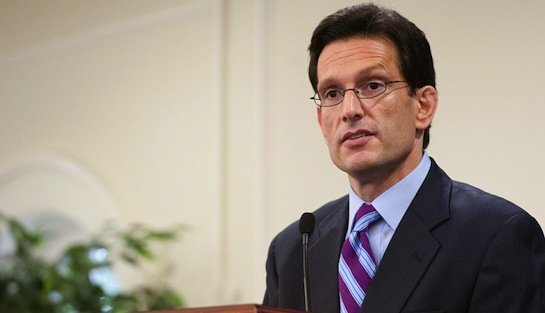
House Majority Leader Eric Cantor says it will be a busy June and July as the House takes up spending bills. He calls for regular order -- a process that’s unlikely in this Congress. (House photo)
House Majority Leader Eric Cantor, R-Virginia, has outlined his congressional agenda for this summer. “We have a busy month ahead of us and July will be just as busy, with our continued focus on making life work for Americans through our conservative solutions,” Cantor wrote to members of the Republican caucus. “During that stretch, members should expect a number of important issues to reach the house floor, including: the continuation of the appropriations process ...” This summer’s budget conclusion -- at least from Cantor’s point of view -- is “regular order” for Appropriations bills for fiscal year 2014 and some sort of resolution of the debt limit. The key message for Indian Country and the programs that serve American Indians and Alaska Natives is the House Fiscal Year 2014 budget will based on the Budget Control Act, the law that gave us the sequester. So, Cantor wrote, “the overall spending level contained in the twelve appropriations bills is written to the sequester-level of $967 billon.” First, it’s interesting that Cantor would again pledge “regular order.” He’s saying the House would pass its budget and appropriations bills and the Senate would do the same. Then a conference committee between the two legislative bodies would negotiate the differences until common ground is found. But it’s misleading at best. Regular order has not happened on the budget. The House, so far, has refused to appoint members to a conference committee with the Senate instead insisting on a “pre-conference” negotiation. An editorial in The New York Times said the House actually prefers chaos to regular order. “Clearly, what is frustrating Republicans is that they do not have an imminent crisis to exploit to get their way,” the editorial said. “Since 2011, they have repeatedly relied on the threat of a government shutdown, or a possible credit default, to force damaging spending cuts. (That is how the sequester was created.)” So even though the process of regular order is not working for the budget -- the big picture review of federal spending -- it is supposed to work for the individual appropriations bills that write checks agency by agency. Let me be clear about this: A regular order on appropriations would be a good thing for Indian Country. There are many friends in the House that could use that process to improve spending on at least key programs, such as health and education. (Remembering of course that the overall budget is somewhere between irresponsible and awful.) At the same time -- and in a contrary move -- the overall Appropriations process will be worse because House Republicans want more money for Defense and to pay for that they will look to cut more domestic spending. It will be up to the Senate to say no. Unfortunately this situation won’t change until after the next election. Because it’s not only the Senate that can say no. Republicans are in a position to halt any new spending, or even a lifting of the sequester itself. South Dakota Sen. John Thune recently told The Washington Post, “I don’t anticipate that the sequester gets turned off. That to me is one of the few areas where we actually have cut spending.” He’s the number three ranking Republican in the Senate so his views are reflective. Those that believe austerity is the right course can point to the shrinking budget deficit. “If the current laws that govern federal taxes and spending do not change, the budget deficit will shrink this year to $642 billion,” the Congressional Budget Office estimates. That’s the smallest shortfall since 2008. CBO says that if you measure the deficit as part of the whole economy, the deficit this year—at 4.0 percent of gross domestic product (GDP)—will be less than half as large as the shortfall in 2009, which was 10.1 percent of GDP. But much of that savings is not coming from the sequester. There was some extra revenue and an increase in payments to the Treasury by housing giants Fannie Mae and Freddie Mac. And, the CBO says, the deficit “reduction results mostly from lower projections of spending for Social Security, Medicare, Medicaid, and interest on the public debt.” So what do all these numbers mean for Indian Country? Most important it means that there will be no easy way to reverse the sequester. At least in this Congress. No matter how many bad stories are written about the impact of the sequester on Indian education, health, or just general governance, there will be a shrug and response that at least the sequester is cutting spending. Mark Trahant is a writer, speaker and Twitter poet. He lives in Fort Hall, Idaho, and is a member of The Shoshone-Bannock Tribes. Join the discussion about austerity. A new Facebook page has been set up at: www.facebook.com/IndianCountryAusterity.
Related Stories
Mark Trahant: Indian Country feels the pain of the sequester (5/20)
Join the Conversation
